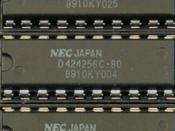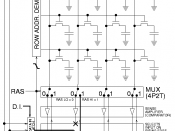Inside your computer, RAM takes the form of separate microchip modules that plug in slots on the computer's motherboard. These slots connect through a bus line or set of electrical paths to the computer's processor. Before you turn on a computer, its RAM is a blank slate. As you start and use your computer, the operating system files, programs and any data currently being used by the processor are written to and stored in RAM, so that the processor can access them quickly.
How is this data written to and stored in RAM? In the most common form of RAM, dynamic random access memory (DRAM), transistors (in this case, acting as switches) and a capacitor (as a data storage element) create a memory cell, which represents a single bit of data.
Memory cells are etched onto a silicon wafer in a series of columns (bitlines) and rows (wordlines), known as an array.
The intersection of a column and row constitutes the address of the memory cell. Each memory cell has a unique address that can be found by counting across columns and then counting down by row. The address of a character consist of a series of memory cell addresses put together.
To write data to RAM, the processor sends the memory controller the address if a memory cell in which to store data. The memory controller organizes the request and sends the column and row addresses in an electrical charge along the appropriate address lines, which are very thin electrical lines etched into RAM chip. This cause the transistors along those addresses lines to close.
These transistors act as a switch to control the flow of electrical current in an either closed or open circuit. While the transistors are closed, the software sends burst if electricity along selected...


